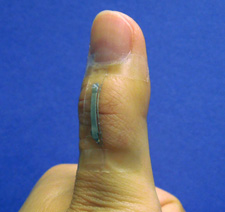North Carolina State University researchers have used silver nanowires to develop wearable, multifunctional sensors that could be used in biomedical, military or athletic applications, including new prosthetics, robotic systems and flexible touch panels. The sensors can measure strain, pressure, human touch and bioelectronic signals such as electrocardiograms.
 A sensor based on silver nanowires is mounted onto a thumb joint to monitor the skin strain associated with thumb flexing. The sensor shows good wearability and large-strain sensing capability. (Photo: Shanshan Yao.)
A sensor based on silver nanowires is mounted onto a thumb joint to monitor the skin strain associated with thumb flexing. The sensor shows good wearability and large-strain sensing capability. (Photo: Shanshan Yao.)
“The technology is based on either physical deformation or “fringing” electric field changes. The latter is very similar to the mechanism used in smartphone touch screens, but the sensors we’ve developed are stretchable and can be mounted on a variety of curvilinear surfaces such as human skin,” says Shanshan Yao, a Ph.D. student at NC State and lead author of a paper on the work.
“These sensors could be used to help develop prosthetics that respond to a user’s movement and provide feedback when in use,” says Dr. Yong Zhu, an associate professor of mechanical and aerospace engineering at NC State and senior author of the paper. “They could also be used to create robotics that can ‘feel’ their environment, or the sensors could be incorporated into clothing to track motion or monitor an individual’s physical health.”
The researchers built on Zhu’s earlier work to create highly conductive and elastic conductors made from silver nanowires. Specifically, the researchers sandwiched an insulating material between two of the stretchable conductors. The two layers then have the ability – called “capacitance” – to store electric charges. Pushing, pulling or touching the stretchable conductors changes the capacitance. The sensors work by measuring that change in capacitance.
“Creating these sensors is simple and low cost,” Yao says. “And we’ve already demonstrated the sensors in several prototype applications.”
For example, the researchers employed these sensors to monitor thumb movement, which can be useful in controlling robotic or prosthetic devices. The researchers also demonstrated an application to monitor knee movements while a test subject is running, walking and jumping.
“The deformation involved in these movements is large, and would break a lot of other sensor devices,” Zhu says. “But our sensors can be stretched to 150 percent or more of their original length without losing functionality, so they can handle it.”
The researchers also developed an array of sensors that can map pressure distribution, which is important for use in robotics and prosthetics applications. The sensors exhibit a quick response time – 40 milliseconds – so strain and pressure can be monitored in real time.
The paper, “Wearable Multifunctional Sensors Using Printed Stretchable Conductors Made Of Silver Nanowires,” is published online in the journal Nanoscale. The work was supported by the National Science Foundation through NC State’s ASSIST Engineering Research Center.
Source: http://www.ncsu.edu/